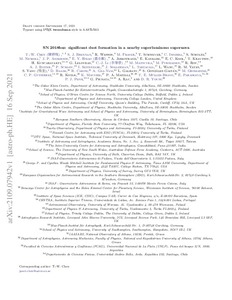SN 2018bsz: significant dust formation in a nearby superluminous supernova
Leloudas G.; Matsuura M.; Li C. -J.; Maguire K.; Young D. R.; Jerkstrand A.; Gonzalez-Gaitan S.; Roy R. Ruiter A. J.; Schulze S.; Rau A.; Tartaglia L.; Inserra C.; Wesson R.; Mueller-Bravo T. E.; Anderson J. P.; Brennan S. J.; Gromadzki M.; Seitenzahl I.; Galbany L.; Kankare E.; Schweyer T.; Gal-Yam A.; Kuncarayakti H.; Kotak R.; Kravtsov T.; Schady P.; Yang S.; Sollerman J.; Kool E. C.; Pignata G.; Pursiainen M.; Chen T. -W.; Baade D.; Hsiao E. Y.; Paraskeva E.; Pessi P. J.; Mazzali P. A.; Wang L.; Carini R.; Nicholl M.; Fraser M.; Gutierrez C. P.; Yates R. M.
https://urn.fi/URN:NBN:fi-fe2022012710630
Tiivistelmä
We investigate the thermal emission and extinction from dust associated with the nearby superluminous supernova (SLSN) 2018bsz. Our dataset has daily cadence and simultaneous optical and near-infrared coverage up to ~ 100 days, together with late time (+ 1.7 yr) MIR observations. At 230 days after light curve peak the SN is not detected in the optical, but shows a surprisingly strong near-infrared excess, with r - J > 3 mag and r - Ks > 5 mag. The time evolution of the infrared light curve enables us to investigate if the mid-infrared emission is from newly formed dust inside the SN ejecta, from a pre-existing circumstellar envelope, or interstellar material heated by the radiation from the SN. We find the latter two scenarios can be ruled out, and a scenario where new dust is forming in the SN ejecta at epochs > 200 days can self-consistently reproduce the evolution of the SN flux. We can fit the spectral energy distribution well at +230 d with 5 x 10^-4 solar mass of carbon dust, increasing over the following several hundred days to 10^-2 solar mass by +535 d. SN 2018bsz is the first SLSN showing evidence for dust formation within the SN ejecta, and appears to form ten times more dust than normal core-collapse SNe at similar epochs. Together with their preference for low mass, low metallicity host galaxies, we suggest that SLSNe may be a significant contributor to dust formation in the early Universe.
Kokoelmat
- Rinnakkaistallenteet [19249]
